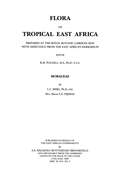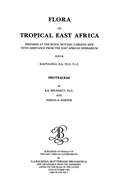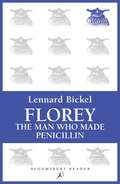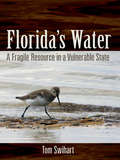- Table View
- List View
Flora of Tropical East Africa - Moraceae (1989)
by R. M. PolhillThis book is a comprehensive review of the genera of Moraceae, a family of flowering plants, found in the tropical region of East Africa. It presents information on their character, occurrence, habitat, phenotypic variations and distribution of each of the species under these genera.
Flora of Tropical East Africa - Moraceae (1989)
by R.M. POLHILL, B.A., Ph.D., F.L.S.; C.C. BERG, Ph.D.; Mrs. Maria E.E. HIJMANThis book is a comprehensive review of the genera of Moraceae, a family of flowering plants, found in the tropical region of East Africa. It presents information on their character, occurrence, habitat, phenotypic variations and distribution of each of the species under these genera.
Flora of Tropical East Africa - Musaceae (1993)
by J.M. LockPart of a series on the flora of tropical East Africa, this work considers Musaceae. The flora is prepared at Royal Botanic Gardens, Kew in close collaboration with East African Herbarium and in liaison with the University of Dar es Salaam, the University of Nairobi and the Makerere University. Significant contributions are also made by specialists from elsewhere. The flora should be a useful reference for anyone concerned with the identification and utilization of plants in eastern Africa. Each family is published as a separate part. New parts are published annually. All back volumes are also available.
Flora of Tropical East Africa - Musaceae (1993)
by J.M. LockPart of a series on the flora of tropical East Africa, this work considers Musaceae. The flora is prepared at Royal Botanic Gardens, Kew in close collaboration with East African Herbarium and in liaison with the University of Dar es Salaam, the University of Nairobi and the Makerere University. Significant contributions are also made by specialists from elsewhere. The flora should be a useful reference for anyone concerned with the identification and utilization of plants in eastern Africa. Each family is published as a separate part. New parts are published annually. All back volumes are also available.
Flora of Tropical East Africa - Polypodiaceae (2001)
by Bernard VerdcourtPart of a series on the flora of tropical East Africa, this work considers Polypodiaceae. The flora is prepared at Royal Botanic Gardens, Kew in close collaboration with East African Herbarium and in liaison with the University of Dar es Salaam, the University of Nairobi and the Makerere University. Significant contributions are also made by specialists from elsewhere. The flora should be a useful reference for anyone concerned with the identification and utilization of plants in eastern Africa. Each family is published as a separate part. New parts are published annually.
Flora of Tropical East Africa - Polypodiaceae (2001)
by Bernard VerdcourtPart of a series on the flora of tropical East Africa, this work considers Polypodiaceae. The flora is prepared at Royal Botanic Gardens, Kew in close collaboration with East African Herbarium and in liaison with the University of Dar es Salaam, the University of Nairobi and the Makerere University. Significant contributions are also made by specialists from elsewhere. The flora should be a useful reference for anyone concerned with the identification and utilization of plants in eastern Africa. Each family is published as a separate part. New parts are published annually.
Flora of Tropical East Africa - Proteaceae (1993)
by R. K. Brummitt Serena K. MarnerPart of a series on the flora of tropical East Africa, this work considers Proteaceae. The flora is prepared at Royal Botanic Gardens, Kew in close collaboration with East African Herbarium and in liaison with the University of Dar es Salaam, the University of Nairobi and the Makerere University. Significant contributions are also made by specialists from elsewhere. The flora should be a useful reference for anyone concerned with the identification and utilization of plants in eastern Africa. Each family is published as a separate part. New parts are published annually. All back volumes are also available.
Flora of Tropical East Africa - Proteaceae (1993)
by R. K. Brummitt Serena K. MarnerPart of a series on the flora of tropical East Africa, this work considers Proteaceae. The flora is prepared at Royal Botanic Gardens, Kew in close collaboration with East African Herbarium and in liaison with the University of Dar es Salaam, the University of Nairobi and the Makerere University. Significant contributions are also made by specialists from elsewhere. The flora should be a useful reference for anyone concerned with the identification and utilization of plants in eastern Africa. Each family is published as a separate part. New parts are published annually. All back volumes are also available.
Flora of Tropical East Africa - Verbenaceae (1992)
by B VerdcourtThis book is a comprehensive review of the genera of Verbenaceae, a flowering plant family, found in tropical East Africa. It presents information on their character, occurrence, habitat, phenotypic variations and distribution of each of the species under these genera.
Flora of Tropical East Africa - Verbenaceae (1992)
by B VerdcourtThis book is a comprehensive review of the genera of Verbenaceae, a flowering plant family, found in tropical East Africa. It presents information on their character, occurrence, habitat, phenotypic variations and distribution of each of the species under these genera.
Flora of Tropical East Africa - Xyridaceae (1999)
by J. M. LockThe flora is prepared at Royal Botanic Gardens, Kew, in close collaboration with East African Herbarium and in liaison with the University of Dar es Salaam, the University of Nairobi and the Makerere University. Significant contributions are also made by specialists elsewhere. The flora is designed to a high academic standard and should be a useful resource reference for anyone concerned with the identification and utilization of plants in eastern Africa. Each family is published as a separate part.
Flora of Tropical East Africa - Xyridaceae (1999)
by J. M. LockThe flora is prepared at Royal Botanic Gardens, Kew, in close collaboration with East African Herbarium and in liaison with the University of Dar es Salaam, the University of Nairobi and the Makerere University. Significant contributions are also made by specialists elsewhere. The flora is designed to a high academic standard and should be a useful resource reference for anyone concerned with the identification and utilization of plants in eastern Africa. Each family is published as a separate part.
Florey: The Man Who Made Penicillin
by Lennard BickelIt wouldn't be for years after that fateful day when Alexander Fleming sneezed on a petri dish and stumbled upon Penicillin, that the almost miraculous power of this mould would transform the lives of every person on the planet. In Florey, The Man Who Made Penicillin we follow the life of Howard Walter Florey, who worked tirelessly for years with his dedicated team at Oxford to realise the potential of not only penicillin, but also the huge breadth of 'tailor made' antibiotics. Born in Australia, Florey left Adelaide for Oxford on a Rhodes scholarship after graduating in medicine, seeking a career in medical science. In a time when an infection from a thorn scratch could lead to a long and painful death, and meningitis, rheumatic fever, venereal disease and other bacterial infections had meant certain doom, the idea of an antibiotic that could treat all of these afflictions was almost unimaginable. In the aftermath of WW1, when septicaemia and gas gangrene had claimed the lives of so many young men, the need for antibiotics had never been keener. First published in 1972, Florey, the Man Who Made Penicillin tracks Florey's battle with funding, the many set-backs and limitations of his equipment and public opinion, and the fascinating journey that led humankind to Penicillin. Whist Fleming got the lion's share of the credit, it was Florey who truly gave the world Penicillin.
Floriculture and Ornamental Plants (Handbooks Of Crop Diversity: Conservation And Use Of Plant Genetic Resources Ser. #3)
by S. K. Datta Youdh Chand GuptaFlorida's Water: A Fragile Resource in a Vulnerable State
by Tom SwihartFlorida's Water poses fundamental questions about water sustainability in the United States' fourth largest state. Florida has long-standing water quality problems. Global climate change threatens to intensify Florida's floods and droughts, make hurricanes more common or more damaging, and eventually submerge much of low-lying Florida, including the Everglades. How can Florida meet these extraordinary challenges? And what lessons does the Florida experience hold for other states? This book fully integrates the many diverse responsibilities of water management into a readable and compelling combination of interesting narratives and deep analysis. Author Tom Swihart's unique, intimate knowledge of Florida's successes and failures in water management brings out both the novelty of Florida's water situation and the features that it has in common with other states.
Florida's Water: A Fragile Resource in a Vulnerable State
by Tom SwihartFlorida's Water poses fundamental questions about water sustainability in the United States' fourth largest state. Florida has long-standing water quality problems. Global climate change threatens to intensify Florida's floods and droughts, make hurricanes more common or more damaging, and eventually submerge much of low-lying Florida, including the Everglades. How can Florida meet these extraordinary challenges? And what lessons does the Florida experience hold for other states? This book fully integrates the many diverse responsibilities of water management into a readable and compelling combination of interesting narratives and deep analysis. Author Tom Swihart's unique, intimate knowledge of Florida's successes and failures in water management brings out both the novelty of Florida's water situation and the features that it has in common with other states.
Flotation Reagents: Volume 2: Applications
by Dianzuo WangThis volume presents essential information on chemical reagents commonly used in flotation processes. It comprehensively summarizes the properties, preparation and applications of collectors, frothers, depressants and flocculants. It also discusses the microanalysis of flotation reagents and adsorption measurement. The book offers a valuable resource for all university researchers and students, as wells as R&D engineers in minerals processing and extractive metallurgy who wish to explore innovative reagents and technologies that lead to more energy efficient and environmentally sustainable solutions.
Flotation Reagents: Volume 1: Functional Principle
by Dianzuo WangThis book summarizes the author’s findings on the functional principle of flotation reagents, gathered over the past few decades. The fundamentals of and approaches common to surface chemistry are applied to study the reagents’ structure and performance, as well as their interaction with minerals. In particular, the book establishes the theoretical criteria for collector performance. It also includes the quantum chemistry parameters, steric configuration, HOMO and LUMO surface of various reagents. The book offers a valuable resource for all university graduate students, researchers and R&D engineers in minerals processing and extractive metallurgy who wish to explore innovative reagents and technologies that lead to more energy efficient and environmentally sustainable solutions.
Flotation Technology: Volume 12 (Handbook of Environmental Engineering #12)
by Lawrence K. K. Wang Nazih K. K. Shammas William A. A. Selke Donald B. B. AulenbachThe past 30 years have seen the emergence of a growing desire worldwide that positive actions be taken to restore and protect the environment from the degrading effects of all forms of pollution – air, water, soil, and noise. Since pollution is a direct or indirect consequence of waste, the seemingly idealistic demand for “zero discharge” can be construed as an unreal- tic demand for zero waste. However, as long as waste continues to exist, we can only attempt to abate the subsequent pollution by converting it to a less noxious form. Three major questions usually arise when a particular type of pollution has been identi?ed: (1) How serious is the pollution? (2) Is the technology to abate it available? and (3) Do the costs of abatement justify the degree of abatement achieved? This book is one of the volumes of the Handbook of Environmental Engineering series. The principal intention of this series is to help readers formulate answers to the last two questions above. The traditional approach of applying tried-and-true solutions to speci?c pollution p- blems has been a major contributing factor to the success of environmental engineering and has accounted in large measure for the establishment of a “methodology of pollution control. ” However, the realization of the ever-increasing complexity and interrelated nature of current environmental problems renders it imperative that intelligent planning of pollution abatement systems be undertaken.
Flow Adaptive Schemes
by Vendrana KutijaA study in the development of flow adaptive numerical schemes in computational hydraulics directed to enhancing modelling capabilities. Examples covered include additional flow resistance due to flexible vegetation; one-dimensional supercritical flow; and flow in networks of channels.
Flow Adaptive Schemes
by Vendrana KutijaA study in the development of flow adaptive numerical schemes in computational hydraulics directed to enhancing modelling capabilities. Examples covered include additional flow resistance due to flexible vegetation; one-dimensional supercritical flow; and flow in networks of channels.
Flow and Combustion in Advanced Gas Turbine Combustors (Fluid Mechanics and Its Applications #102)
by Johannes Janicka, Amsini Sadiki, Michael Schäfer and Christof HeegerWith regard to both the environmental sustainability and operating efficiency demands, modern combustion research has to face two main objectives, the optimization of combustion efficiency and the reduction of pollutants. This book reports on the combustion research activities carried out within the Collaborative Research Center (SFB) 568 “Flow and Combustion in Future Gas Turbine Combustion Chambers” funded by the German Research Foundation (DFG). This aimed at designing a completely integrated modeling and numerical simulation of the occurring very complex, coupled and interacting physico-chemical processes, such as turbulent heat and mass transport, single or multi-phase flows phenomena, chemical reactions/combustion and radiation, able to support the development of advanced gas turbine chamber concepts
Flow and Combustion in Reciprocating Engines (Experimental Fluid Mechanics)
by C. Arcoumanis T. KamimotoOptimization of combustion processes in automotive engines is a key factor in reducing fuel consumption. This book, written by eminent university and industry researchers, investigates and describes flow and combustion processes in diesel and gasoline engines.
Flow and Heat and Mass Transfer in Laminar and Turbulent Mist Gas-Droplets Stream over a Flat Plate (SpringerBriefs in Applied Sciences and Technology)
by Victor I. Terekhov Maksim A. PakhomovIn this book the author presents selected challenges of thermal-hydraulics modeling of two-phase flows in minichannels with change of phase. These encompass the common modeling of flow boiling and flow condensation using the same expression. Approaches to model these two respective cases show, however, that experimental data show different results to those obtained by methods of calculation of heat transfer coefficient for respective cases. Partially that can be devoted to the fact that there are non-adiabatic effects present in both types of phase change phenomena which modify the pressure drop due to friction, responsible for appropriate modelling. The modification of interface shear stresses between flow boiling and flow condensation in case of annular flow structure may be considered through incorporation of the so called blowing parameter, which differentiates between these two modes of heat transfer. On the other hand, in case of bubbly flows, the generation of bubbles also modifies the friction pressure drop by the influence of heat flux. Presented are also the results of a peculiar M-shape distribution of heat transfer coefficient specific to flow boiling in minichannels. Finally, some attention is devoted to mathematical modeling of dryout phenomena. A five equation model enabling determination of the dryout location is presented, where the mass balance equations for liquid film, droplets and gas are supplemented by momentum equations for liquid film and two-phase core.
Flow and Transport in Fractured Porous Media
by Peter Dietrich Heinz Hötzl Jürgen Köngeter Rainer Helmig Martin Sauter Georg TeutschThis book addresses the characterization of flow and transport in porous fractured media from experimental and modeling perspectives. It provides a comprehensive presentation of investigations performed and analyzed on different scales.
















